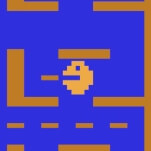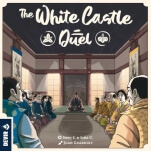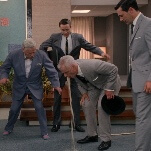Consoles used to be dumb beasts. In the days of the NES and the Sega Genesis, if you turned on a console without inserting a video game first, the machine would sit there blinking in panic. “You have to feed me a game,” it would say, wordlessly. “That’s how this relationship works. You feed me a game, and I let you play it.”
Now the beasts feed themselves. When you start up an Xbox 360, you get a panoply of entertainments and marketing come-ons that the console gobbles from Microsoft’s servers and regurgitates on your screen. Apps, movie trailers, and deodorant commercials flood the display in a reasonable facsimile of the eyeball-searing TVs in Idiocracy. The PS3’s XrossMediaBar interface is not as garish, but it too has seen marketing metastasis take hold. (Plus, it’s as confusing as you’d expect something called the XrossMediaBar to be.)
Sony’s engineers unwittingly started this whole mess when they used the PlayStation 2 as a Trojan horse to get DVD players into people’s homes while the format was still young and unproven. After that huge success, Sony, Microsoft, and (belatedly, halfheartedly) Nintendo viewed their game machines as media boxes whose anything-and-everything feature sets could “conquer the living room”—the quixotic dream of every major electronics maker.
The added capabilities aren’t unwelcome in themselves. DVD playback was a fantastic feature for the PS2 the same way that, say, Netflix and Major League Baseball apps are for the PS3. And it’s hard to imagine living without the online game marketplaces that have flourished over the past eight years.
The trouble is that this broadened array of functions has muddled the relationship between player and console. The machines are no longer dumb, loyal servants. Now they are often hucksters and interlopers. They pelt you with ads. They implore you to sign up for their myriad confusing online “services,” and they get irritable if you refuse. They make you wait while they apply mammoth software updates that provide dubious benefit. (I recently sat on my ass for 15 minutes for my PS3 to install a mandatory update that promised to “improve trophy notifications.” My sitting-on-ass time is too precious for that nonsense.)
The PlayStation 4 attempts to restore dignity to the player-console relationship. The $400 device, released last Friday, is more deferential than its predecessor. There’s an unassuming spirit to the PS4 that starts with the industrial design. The machine is a tight form that’s defined by one eye-catching detail—a sharp slope on the front and back faces that gives the box a quiet, confident edge—and a slew of well-considered touches. The power and eject buttons blend into the hardware so seamlessly that they’re practically invisible, and the same goes for the disc slot.
The unit’s indicator light, a long stripe between the glossy and matte sections of the console along the top, is the one element of the exterior that flirts with excess, but it works so well in context that it’s an essential part of the design. When that stripe glows to life, the PS4 seems like a piece of alien technology, with the light hinting at power within. The machine needs that stroke of excitement to complement the silent blackness of the overall look.
This is the type of machine that Sony ought to build. It’s a return to the calm futurism of the PlayStation 2 and a departure from the bulbous flash of the original PlayStation 3, with its plasticky chrome and hideous Spider-Man logo font. Sony falters when it tries to be flashy—the result always ends up feeling like a bunch of starched-shirt Tokyo engineers straining to be cool (because that’s what it is). But historically, no company other than Apple can match the elegance that Sony achieves in its best hardware, and it’s nice to see the company be true to its soul again.
Sony has never been able to execute its design ethos quite as well in software. And indeed, the on-screen interface of the PS4 is less cohesive and self-assured than the console’s exterior. The operating system is always trying to instill some cloudy notion of an electronic “lifestyle.” The main menu, for instance, is backed by a hollow soundtrack that sounds like waiting-room music at a Japanese spa. The undulating swooshes of blue in the background likewise would not be out of place in a promo for a home-shopping network.
Functionally, however, the interface is an improvement. Perhaps the most significant change is the simplest: When you fire up the PS4, it defaults to a menu that displays the half-dozen or so most recent activities you’ve done on the unit. The PS3, conversely, would dump you into the XrossMediaBar and leave you to navigate its homely spindles of functionality. The more down-to-earth approach of the PS4 constitutes a tacit (and welcome) admission that most players use their consoles for only a handful of things rather than availing themselves of every feature on offer.
Although Sony is sure to address bugs in the coming months, the operating system is still glitchy at launch. At least the PS4 crashes with grace, immediately plunking the user back at the main menu. Bugs aside, the software of the PS4 gets in your way much less than the PS3 did. The PlayStation Store is easier to navigate, browsing your game library is more straightforward, and insipid dialog boxes are less frequent. Where the paranoid PS3 practically made you sign in triplicate for simple tasks like creating a new save file, the designers of PS4 have realized that in the year 2013, many people understand how computers work.
Sony’s tendency to nag still pops up in places. When you connect a second controller, for instance—a formerly straightforward task—a dialog appears asking if you’d like to assign a user profile to the gamepad. If your answer is, “No, I would like to please play a game with my friend already,” the PS4 gets a little huffy and asks again—this time for an profile on the PlayStation Network, because the new player needs this to earn trophies. Sony, nobody cares that much about trophies. It’s time to let this one go, buddy.
Updates are somewhat more graceful on the new system, too. You’ll need a 300-megabyte software update to unlock all of the console’s features—especially its online service—and that sounds like a lot. But the system quietly downloads the update in the background rather than pestering you about it, and the installation isn’t so miserably long as updates often were on the PS3. On the other hand, some games and many apps take a while to launch, which is probably a function of a pokey hard drive that comes standard. It’s possible that a future high-end PS4 will come with a snappy solid-state drive built in, but in the meantime, users can easily replace the drive themselves if they want.
The PS4’s DualShock 4 is the best controller that has ever shipped with a new console. The previous DualShocks were already top-tier gamepads, but this controller is full of subtle strokes that make it more comfortable for extended play sessions. The analog joysticks have concave caps, which keep your thumbs in place better than the shallow domes of the DualShock 3. A mix of surface treatments is not only good-looking but functional: Textured grips make the controller easier to hold once it’s inevitably slicked up with sweat and potato-chip grease, while the sharp, smooth surfaces around the face buttons accentuate the buttons’ crisp response.
These refinements offset some of the controller’s more dubious innovations. There’s a speaker in the gamepad now, and some launch titles use it for incidental audio cues, because nothing says “state-of-the-art experience” like tinny screeches and squawks emerging from a 50-cent speaker. The clickable touchpad in the middle of the controller is not so awkward as the “rear touch” area on last year’s PlayStation Vita handheld, but it’s still a bit of a reach, making it unlikely that serious developers will employ it for anything other than gimmicks.
The award for outright dumbest PS4 feature goes to a colored light bar under the rear edge of the controller, which serves practically no function yet always remains on. Not only is this light irritating when you want to, say, watch a movie on your PS4 in a darkened room—I ended up stuffing the controller under a throw pillow in this situation—but it also shortens the already-mediocre battery life of the controller. (It lasts about 60 percent as long as the DualShock 3 by my non-scientific reckoning.) Unlike the PS3, the PS4 can charge a controller while it’s in standby mode, which mitigates the battery shortfall a bit, but intensive users of the console will probably want to invest in a third-party charging accessory, as many PS3 players ended up doing.
Sony sent two disc-based games with the review unit: Knack, a Crash Bandicoot-type platformer featuring action that’s somehow even more forgettable than Crash Bandicoot, and Killzone: Shadow Fall, a video game in which you shoot at people. Both of these games look noticeably sharper and cleaner than comparable games on the PS3, but anyone expecting a “wow!” moment is likely to be disappointed.
The days when new consoles produced instant leaps forward in visual sophistication are long past (but check again in a few years once developers have figured out how to exploit the PS4’s PC-like processor architecture and its generous complement of high-speed memory). In fact, the best-looking exclusive launch title on the PS4—and the most engrossing overall—is a simple downloadable space shoot-’em-up called Resogun. It does for the PS4 what Geometry Wars: Retro Evolved did for the Xbox 360 in its early days, giving players a loud, twitchy, and colorful experience to overwhelm their senses.
And if you want to share that experience with others, Sony would like that very much. The company is so eager for you to flood your friends’ timelines with PlayStation ephemera that it has built “social”—that word is a noun now, in case you haven’t heard—right into the hardware. The PS4 controller ditches the “select” button that has graced gamepads for the past three decades, replacing it with a “share” button. Pressing that magical button pauses the game and brings up a menu in which you can grab a screenshot, upload video of your recent exploits to Facebook, or broadcast your game live on one of two streaming services, Ustream or Twitch.
The rudimentary built-in video editor is easy to use, and the PS4’s ability to act like a DVR and keep a running video buffer of your game is clever. But the console compresses the video aggressively, and as a result, the footage comes out somewhat muddy. (I've embedded a sample above.) Hobbyists who want to record higher-quality footage are out of luck for now, because the PS4 copy-protects its digital video output, and unlike the PS3, there are no analog outputs. But Sony, in a surprising move, has promised that an upcoming software patch will disable the copy protection for game footage.
That’s a minor policy change that only affects a small portion of the game-playing public, and it wouldn’t be worth mentioning except that it’s representative of the friendlier, more subdued attitude that characterizes the PS4. The Xbox 360 and the PS3 both evolved into overbearing machines that made it progressively more difficult to simply play games or watch a movie. They jealously grabbed for more of your attention and put up roadblocks if you resisted. By comparison, the PS4 plays it cool.
Maybe the PS4 is more graceful than those other consoles simply because Sony hasn’t larded it up with “content partnerships” and revenue-generating schemes yet. But it doesn’t feel that way. The console holds the promise of an enduring philosophical shift. The PS4 does have a slew of new features, after all; it’s just that Sony isn’t so insistent about shoving them in your face. Instead, the most appealing features of the PS4 do their work in the background—recording your game video, installing new games, adapting its menus to fit your tendencies.
None of these comforts is spectacular, but the PS4 doesn’t aspire to be a spectacular machine. It is, in a word, dull. And that’s a compliment. The console shouldn’t be the star of the show. The games and the players deserve the spotlight. Sony seems to recognize this, and the PS4 hews closer to the notion of a “platform”—a blank infrastructure on which amazing things can be built.
Players have plenty of time to wait and see if the platform grows into its potential, as there’s no killer exclusive title that makes it worthwhile to run out and buy one right now. But Sony has laid solid groundwork, both in its powerful hardware and its austere software, for a machine that can stand back and let players occupy the stage. If only every console were so boring.








































